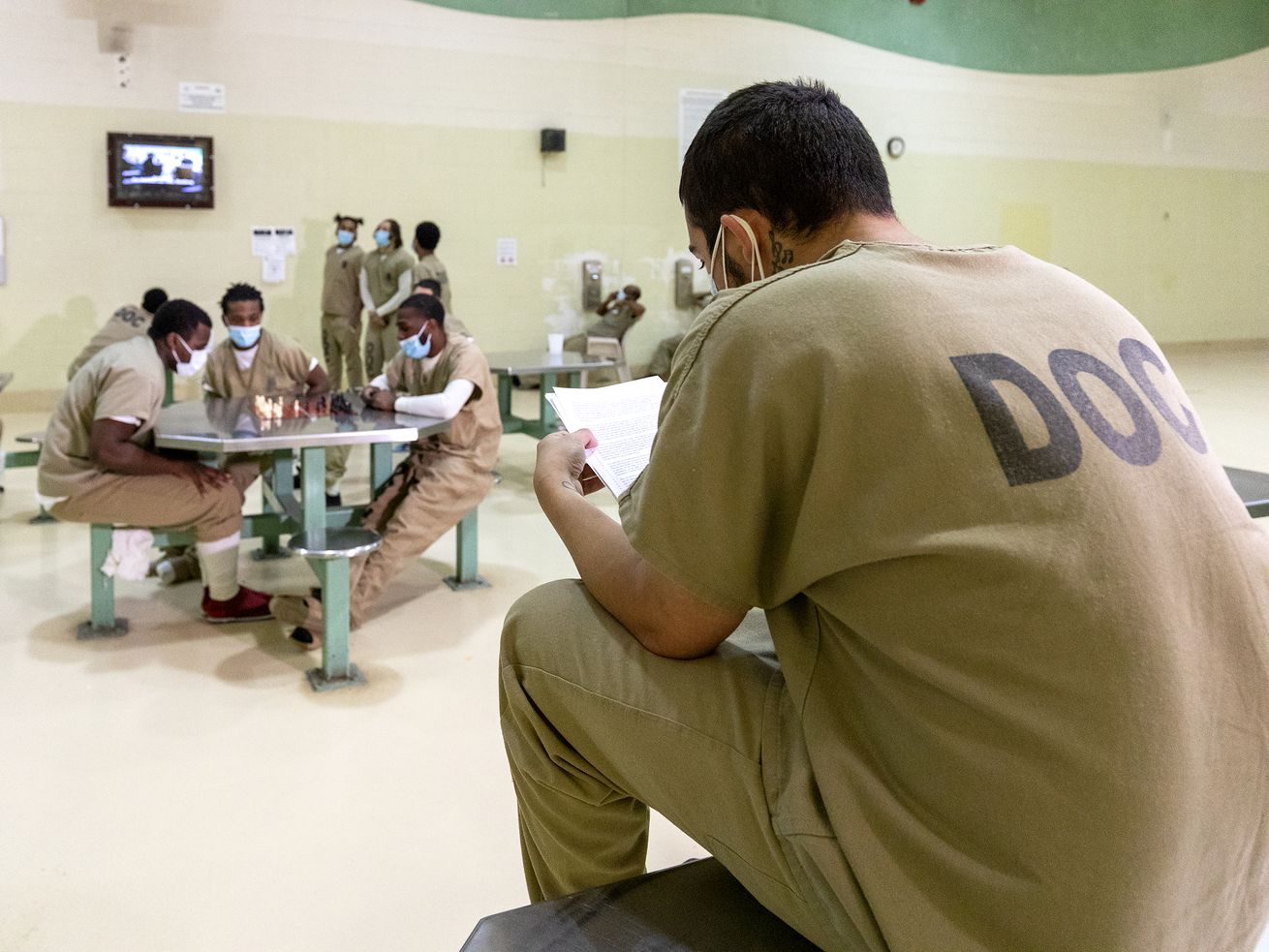Masked
detainees sit inside the Cook County Jail. | Cook County
sheriff’s office
Last week 370 detainees tested positive for the virus, according
to data from the sheriff’s office, surpassing the previous high
from April.
The number of detainees testing positive for the coronavirus at
the Cook County Jail has soared to levels not seen since cases
there last peaked in the spring, when it saw one of the largest
outbreaks of confirmed cases of any location in the country.
Twenty-three detainees at the jail tested positive for the virus
on Nov. 1, according to data from the sheriff’s office. Just over
a month later, the jail set a new record for cases on Dec. 7, with
370.
That’s even higher than the previous peak, 307, on April
10.
The drastic increase in little more than a month illustrates
just how difficult a task it is to control the virus’ spread
inside correctional facilities and how quickly cases can rise.
It’s the situation Sheriff Tom Dart — who himself tested
positive last month —
warned about recently as he stood outside the jail and urged the
public to take measures including wearing masks, socially
distancing and remaining home as much as possible.
Releasing more detainees through alternatives to incarceration,
such as home monitoring, would be the quickest way to bring cases
down again — to protect not only detainees, but also the
community at large, advocates and public officials say.
However, previous attempts to do so have been been met with
criticism that inmates being released were contributing to spikes
in crime, which sources said has made it difficult this fall to
take the same action.
A return to spring levels
In April, county officials brought the facility’s population
down from about 5,500 in February to around 4,000 detainees — its
lowest levels on record — mostly through releasing detainees
determined to be a low risk of public safety and those with health
risks.
Five new areas of the jail’s sprawling campus in Little
Village were also opened to house detainees. Coupled with the lower
population, it allowed the sheriff’s office to move 66% of
detainees into single cells and socially distance detainees in its
dormitory-style housing areas.
The county also started doing widespread testing — 40,000 so
far — and made masks and hygiene products widely available. New
detainees are tested for the virus at intake and quarantined for 14
days before they are tested again — and isolated if they are
positive.
The sheriff’s office has said the high number of infections in
the spring that led to the jail being named a hotspot was the
result of an aggressive effort to test detainees ahead many other
facilities. Other jails around the country have seen higher
caseloads in the months since.
/cdn.vox-cdn.com/uploads/chorus_asset/file/22170613/Jail_COVID_MONDAY.png) Cook
Cook
County sheriff’s office Tracking coronavirus cases at the Cook
County Jail.
Those efforts worked, public heath officials say.
Detainees testing positive for the virus fell from the April
high to only a few dozen throughout the summer months.
“The depopulation measures initiated during the spring surge
were critical in containing the virus at the jail,” said Jesus M.
Estrada, chief operating officer of Cermak Health Services, which
provides healthcare to the jail.
But at the same time, the jail’s population was steadily
rising again, records show, and they have since reached levels last
seen in February.
Currently, only 38% of detainees are being housed in single
cells, Curry said.
“The population being up has definitely made our job more
difficult,” Curry said. “You go from a dormitory with 14
[detainees] up to 34 … it makes distancing and isolation more
difficult.”
The sheriff’s office also instituted a new mandate this week
that requires correctional officers be tested for the virus before
they can return to work if they have potentially be exposed, Curry
said.
/cdn.vox-cdn.com/uploads/chorus_asset/file/22163870/Div11_1.jpg) Cook
Cook
County sheriff’s office Detainees at the Cook County Jail are
seated apart while using the phones. ‘It takes time’
Even though there has been talk that jail detainees around the
country should be prioritized to receive COVID-19 vaccines, nothing
has been finalized and a rollout will take time. In the meantime,
Public Defender Amy Campanelli says efforts to depopulate the jail
must be made again.
“The jail’s population needs to be reduced to keep the
community safe,” Campanelli said. “We’re not giving
[detainees] a break, they still have to fight their cases, they can
just do it from outside.”
In March,
her office filed a motion to review bail for detainees that met
criteria in seven categories, including those with medical
conditions, pregnant women, non-violent offenders and detainees
eligible for probation,
which led to the review of thousands of cases for potential
release.
Campanelli has continued to file motions to review bonds for
detainees, “but I cannot force the judges to release them. I
cannot force the state’s attorney’s office to agree to the
release.”
A spokeswoman for Chief Judge Tim Evans said his office has
provided a list of inmates to “determine which detainees may be
eligible” for release. The state’s attorney’s office also
agreed that the number of inmates awaiting trial should be
diminished — regardless of the pandemic — as a part of overall
bail reform.
But several sources familiar with the situation, who asked not
to be named as to not hurt discussions, said a sticking point has
been backlash stemming from the civil unrest and increased crime
that took place over the summer —
particularly after criticism from Mayor Lori Lightfoot and Chicago
Police Supt. David Brown.
And even if all sides agree more prisoners should be let go,
“it takes time to do that,” Campanelli said.
Transfers to state prisons slows
To start, the Illinois Department of Corrections could accept
the transfer of the more than 450 people who should be in their
custody anyways, the sheriff’s office said.
Transfers to prisons from jails were halted last spring by state
order to prevent the spread of the virus between facilities, but
have since resumed, albeit at significantly reduced levels.
IDOC is currently accepting about 50-60 people each week from
the jail, according to Curry, down from an average of about 400
people a week before the pandemic. In October, IDOC acting director
Rob Jeffreys told lawmakers that the state’s prison population
was at its lowest level since the 1990s.
Asked why IDOC isn’t accepting more detainees from Cook
County, a spokeswoman said “intakes are scheduled based on space
availability, quarantine requirements and COVID-19 test
results.”
Advocates push for action
Advocates say the situation is dire.
“The sense of urgency we were seeing [in the spring] just
isn’t there now,” said Alexa Van Brunt, an attorney with
Northwestern University’s MacArthur Justice Center Clinic who
sued the sheriff’s department earlier this year to release
detainees.
Public officials “have been watching the jail population go up
all summer,” Van Brunt said. “They should have been taking
action all along.”
As of Nov. 30, 529 people were being held at the jail because
they couldn’t afford to post $5,000 in bond or less, said Sarah
Staudt, an attorney with the nonprofit Chicago Appleseed Fund for
Justice.
Staudt also cited 265 people held solely on a misdemeanor
charge, or the 106 people who have be held in the jail for more
than a year on Class 3 and lower felony charges — and would
likely be sentenced to little if any prison time even if they are
eventually convicted — as being likely candidates for
release.
“This is a complex problem, but we know how to do it,”
Staudt said. “We did it in the spring and I’m sure that saved
lives.
“It’s past time for stakeholders to move on this.”



















